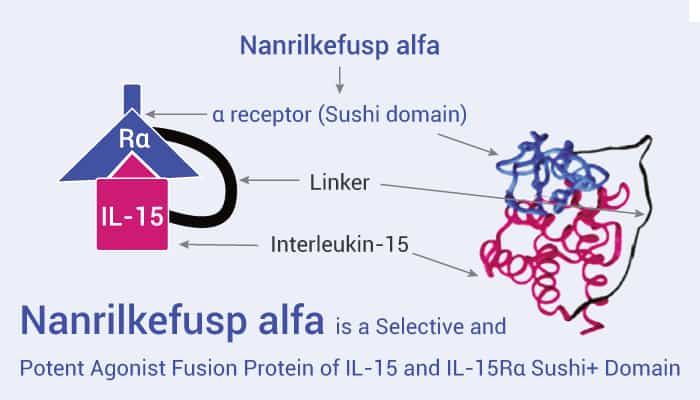IL-15 is a cytokine involved in the regulation of the innate immune system. It stimulates the proliferation and activation of natural killer (NK) cells and memory CD8+ T cells. And also it promotes the secretion of a variety of cytokines. Moreover, IL-15 enhances the antibody-dependent cytotoxicity (ADCC) of antibodies. Specifically, in ADCC, the Fc-antibody targets tumor cells and also binds to CD16 receptors on the surface of NK cells. Degranulation of NK cells and target tumor cell lysis occurred under receptor cross-linking. Therefore, NK can not only resist viral infection but also control the development and progression of tumors. NK cells have two main subpopulations, CD56dim, and CD56bright. They will inhibit the metastasis and migration of primary tumor cells. They are mediated by activated IL-15 to perform cytotoxic effects on tumor cells. Here, we will introduce a selective and potent agonist of IL-15, the Nanrilkefusp alfa.
Nanrilkefusp alfa consists of IL-15Rα Sushi+ Domain potently activates the IL-15 pathway.

In general, Nanrilkefusp alfa couples with IL-15 via the sushi+ domain to effectively activate IL-15. Nanrilkefusp alfa (0.01-10 nM; 7 d) expands the amplification of NK cell isoforms from human PBMC and activates NK cells. Moreover, it (0.1, 1, and 10 nM; 3 d and 7 d) induces the expression of cytotoxic receptors NKp30, DNAM-1 and NKG2D on NK cells. Therefore, it (1 nM; 20 h) further induces cytotoxicity and tumor cell-killing activity of NK cells.
However, Nanrilkefusp alfa also has strong anti-metastasis activity and anti-tumor efficacy in vivo. Nanrilkefusp alfa (2 mg/kg; s.c.; 4 consecutive days over 2 weeks) reduces NK cell and CD8+ T cell-dependent tumor growth metastatic kidney cancer Renca mouse model. This process is accompanied by the activation of toxic genes in TC-1 tumors (same in vitro results). Nanrilkefusp alfa (1 mg/kg; i.p.; 4 consecutive days over 2 weeks) also shows synergistic tumor inhibition with anti-PD-1 antibodies in an established mouse TRAMP-C2 tumor model. It increases the number of CD8+ T cells and NK cells but does not increase T-regulatory cells (Tregs).
In summary, Nanrilkefusp alfa contains the IL-15Rα Sushi+ domain, which effectively activates the IL-15 pathway. It promotes the proliferation and activation of immune cells, and has anti-metastasis and cell activity against tumor cells.
Reference:
[1] Antosova Z, et al. Front Immunol. 2022 Oct 10;13:989895.
[2] Adkins I, et al. Cancer Research, 2020, 80(16_Supplement): 6686-6686.